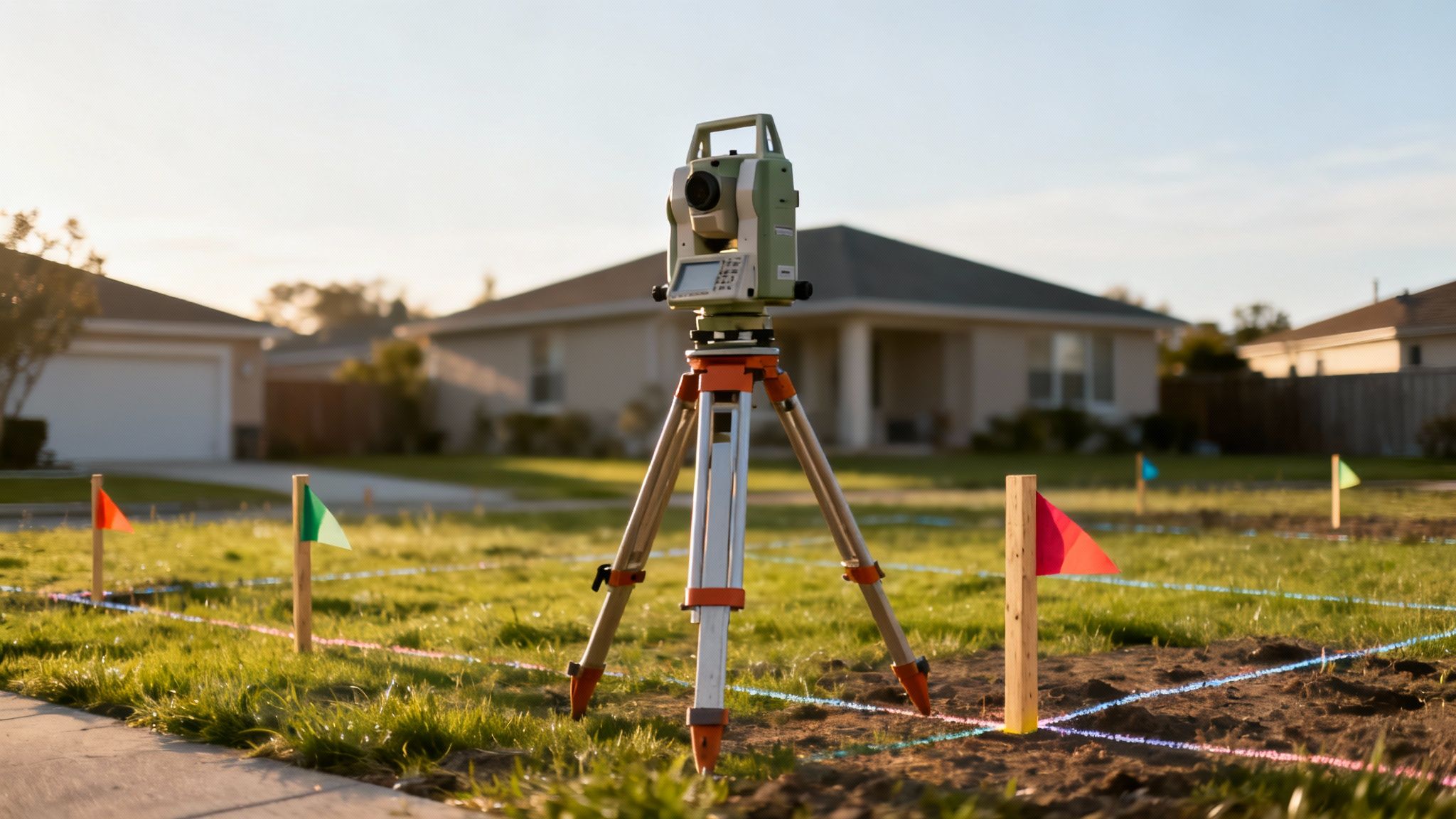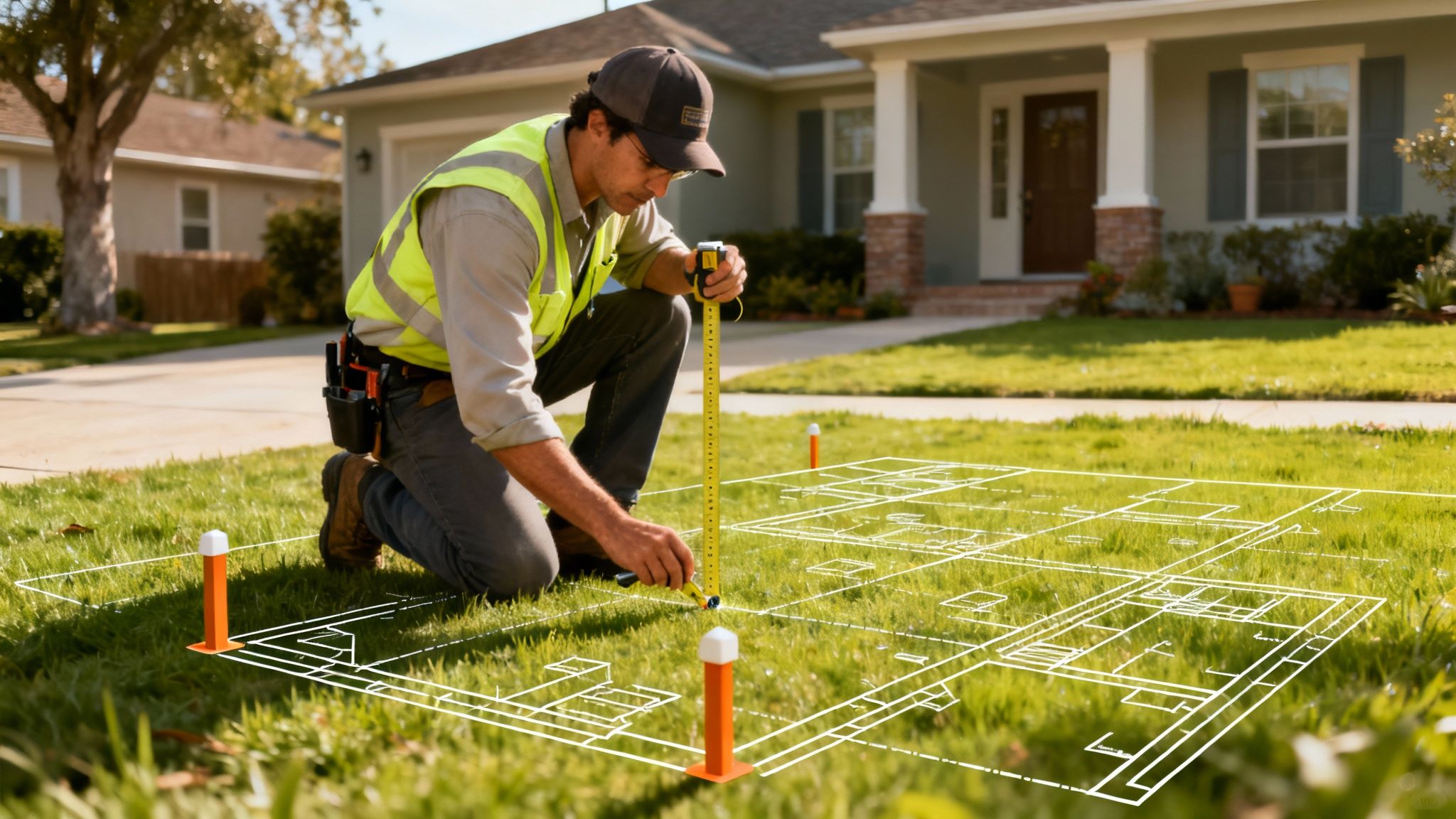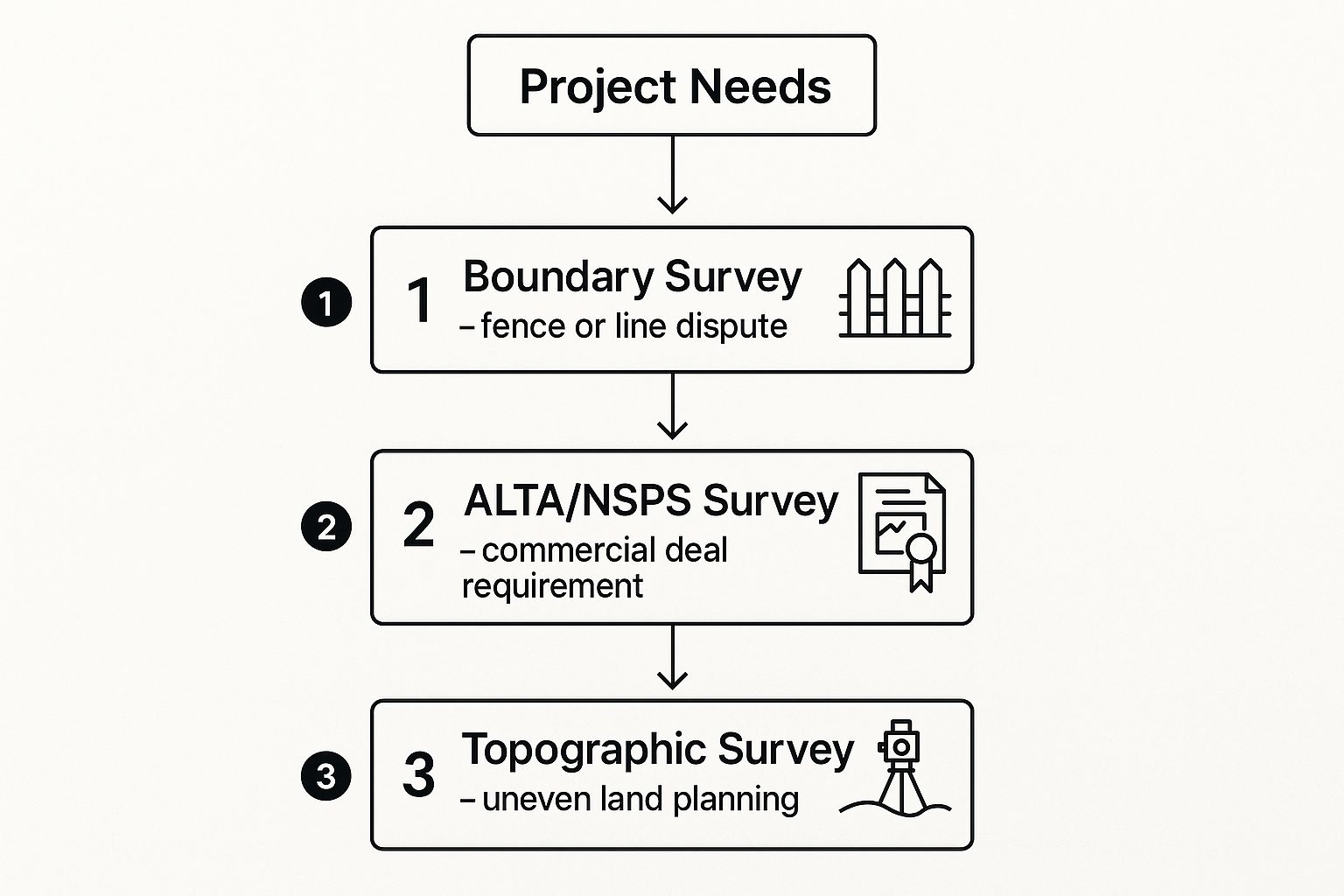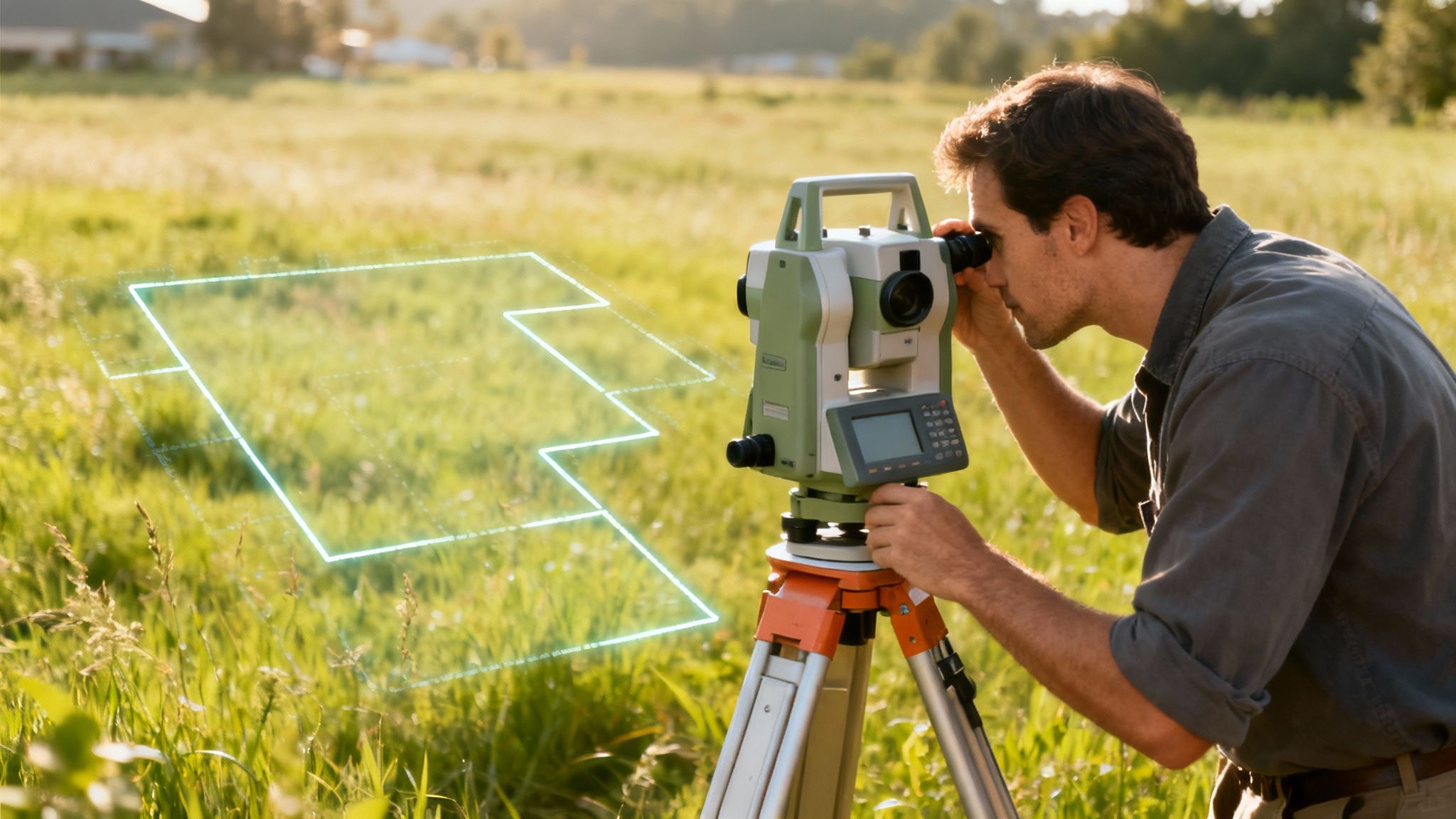What Is a Property Survey? Essential Insights for Your Investment

Ever wonder what a property survey really is? Think of it less as a simple map and more as your property's official, legally-binding blueprint. It's a detailed drawing that shows you exactly where your land begins and ends, pinpoints the location of buildings, and flags any legal rights-of-way that could affect how you use your property.
Unpacking Your Property's Blueprint

Picture this: you buy your dream home, only to find out a year later that the beautiful oak tree you fell in love with is actually on your neighbor's land. This is exactly the kind of costly, frustrating surprise a property survey is designed to prevent.
A licensed surveyor uses highly specialized equipment to create a comprehensive report that provides a clear, legally recognized picture of what you own. It's not just about avoiding arguments over where to put a fence; a survey is a crucial tool for uncovering hidden details about a property you'd never spot otherwise. Going without one is like buying blind—you're opening yourself up to potential problems that could be a nightmare to fix down the road.
Why a Survey Is More Than Just a Map
A professional survey goes far beyond just measuring the dimensions of your lot. It digs into the crucial legal and physical details of the land, giving you a vital layer of protection for what is likely the biggest investment you'll ever make.
The global land survey equipment market is valued at around USD 8.87 billion, which gives you a sense of the sophisticated technology and precision that goes into this work. You can learn more about the scale of the land survey industry to see how seriously it's taken.
Here are a few key details a good survey will uncover:
- Boundary Lines: It establishes the exact, legally-defensible boundaries of your land, which is your best defense against someone building on your property.
- Easements: It identifies any legal rights that others might have to use a portion of your land—think utility companies needing access to power lines.
- Encroachments: It reveals if a neighbor's fence, shed, or driveway is creeping over onto your property.
- Zoning Compliance: It can show whether the existing buildings meet local zoning rules, like how far they must be set back from the property line.
Ultimately, a property survey is your first line of defense. It gives you the concrete proof you need to protect your ownership rights. It's also a foundational document that lenders and title insurance companies count on to reduce their risk and make sure the whole transaction is secure.
Choosing the Right Type of Property Survey
Picking a property survey isn't a one-size-fits-all deal. Think of it like a doctor's visit—you wouldn't want a heart specialist for a broken bone. In the same way, surveyors have different tools and techniques for specific situations. Choosing the right one means you get exactly the information you need, without overpaying for data that doesn't matter for your project.
The purpose of your project dictates the type of survey you'll need. Are you putting up a fence? Securing a commercial loan? Or maybe planning a massive new development? Each of these scenarios calls for a different kind of survey, and knowing the difference will help you avoid some serious headaches down the road.
Common Surveys for Homeowners and Developers
For most everyday property needs, you'll likely run into one of a few common types.
The Boundary Survey is the bread and butter of the industry. This is the one you need to officially establish your property lines. If you're building a fence, adding a shed, or just want to know for sure where your land ends and your neighbor's begins, a boundary survey is your go-to. A surveyor will physically mark the corners so there’s no guesswork.
Then there's the Topographic Survey. Most land isn't perfectly flat, and this survey is all about mapping its unique features—the hills, valleys, slopes, and dips. It's absolutely critical for any construction or significant landscaping project. Architects and engineers use it to figure out drainage patterns and determine the best spot for a foundation. In places like California, they're even used to map potential mudslide paths after a wildfire, showing just how vital they can be.
A survey is more than just a document; it’s a preventative tool. Choosing the right one upfront can save you from significant financial and legal headaches, transforming a potential liability into a well-managed asset.
This infographic breaks down how your specific needs line up with the different survey options.

As you can see, a clear goal—like resolving a boundary dispute or closing a commercial deal—points you directly to a specific type of survey.
Which Property Survey Do You Need?
Feeling a little lost in the options? This quick-reference table breaks down the most common survey types to help you find the right fit for your situation.
| Survey Type | Primary Purpose | When You Typically Need It |
|---|---|---|
| Boundary Survey | To officially locate and mark your property's legal boundary lines. | Before building a fence, resolving neighbor disputes, or confirming property size. |
| Topographic Survey | To map the natural and man-made features and elevations of a piece of land. | Before any construction, landscaping, or engineering design project. |
| ALTA/NSPS Land Title Survey | To provide a comprehensive report for lenders and title insurers. | During the due diligence phase of commercial real estate transactions or for complex loans. |
| As-Built Survey | To document the final location of newly constructed improvements on a property. | After construction is finished to close out permits and verify compliance with plans. |
Ultimately, having a quick chat with a licensed surveyor is the best way to confirm you're on the right track.
Specialized Surveys for Complex Transactions
When the stakes get higher, especially in the world of commercial real estate, you need a survey that digs much deeper.
The ALTA/NSPS Land Title Survey is the industry's gold standard. It’s an incredibly detailed report created to meet the demanding requirements of lenders, attorneys, and title insurance companies. It pulls together elements from boundary, topographic, and location surveys and adds critical information about easements, encroachments, and anything else that might impact the property's legal title.
Finally, an As-Built Survey happens after the work is done. This survey shows the exact final location of all new improvements—a new building, a swimming pool, a major home addition—to confirm everything was built according to the approved plans. Municipalities often require one to officially close out building permits, making it the last crucial step in a construction project.
How the Property Survey Process Actually Works

It’s easy to wonder what really happens between hiring a surveyor and getting that final map in your hands. The whole thing can seem a bit mysterious. The best way to think of a surveyor is as a property detective. They piece together clues from historical records and on-the-ground evidence to create a definitive, legally sound picture of your land.
The process is far more involved than just walking the property with high-tech gear. It’s a methodical, detailed investigation that unfolds in a few key stages, with each step building on the last to guarantee the final report is rock-solid.
Stage 1: The Research Phase
Interestingly, the work doesn't start out in the field. It begins in an office, surrounded by stacks of historical documents. Before a surveyor ever sets foot on your land, they dive deep into the records. This research is a cornerstone of the entire due diligence process.
They'll pull everything they can find: old deeds, previous surveys, subdivision maps, and public land records for your property and all the adjoining ones. For a closer look at everything involved, you can check out our detailed real estate due diligence checklist.
This archival dig helps the surveyor piece together the property's legal history and uncover any recorded easements or boundary agreements. It's like a historian creating a timeline for the land, which provides crucial context before they go out to gather new evidence.
Stage 2: The Fieldwork
With a solid historical foundation in place, the surveyor heads out to the property. This is the part everyone imagines—the boots-on-the-ground measurement. Using a mix of sophisticated tools like GPS receivers, robotic total stations, and sometimes even 3D scanners, the team meticulously measures every aspect of the site.
They hunt down existing property corners, which are often marked by old iron pins or monuments buried just below the surface. From there, they measure the precise location of all improvements on the land.
This includes things like:
- Buildings and sheds
- Fences and retaining walls
- Driveways and sidewalks
- Visible utility lines and equipment
This isn't just about measuring straight lines. It’s about collecting thousands of precise data points that will be used to build a highly accurate digital map of the property.
A property survey is a blend of historical investigation and modern scientific measurement. The fieldwork provides the "ground truth" that is later compared against the historical records to identify and resolve any inconsistencies.
Stage 3: The Analysis and Drafting
Finally, it's back to the office to connect all the dots. The surveyor imports all the field data into specialized computer-aided design (CAD) software and overlays it on top of their historical research. This is where their expertise truly comes into play, as they work to reconcile any differences between what an old deed says and what their modern instruments have measured.
They analyze every piece of information to establish the final boundary lines, note any encroachments (like a neighbor's fence that's over the line), and identify any easements. The culmination of all this work is a detailed drawing, often called a plat, and a formal written report. This final document becomes the legally recognized map of your property—an essential tool for protecting your investment for years to come.
So, What Does a Property Survey Actually Cost?
It’s one of the first questions on every buyer's mind: "How much is this going to set me back?" The truth is, there's no simple, one-size-fits-all price tag for a property survey. The cost is a direct reflection of the work and complexity involved in mapping out your specific piece of land.
For most residential properties, you can expect the cost to land somewhere between a few hundred and several thousand dollars. Why such a big range?
Think of it this way. Surveying a small, perfectly square lot in a modern subdivision with great public records is like putting together a simple jigsaw puzzle. All the pieces are right there. But surveying a huge, forested property with steep hills, a winding creek, and vague historical deeds? That’s more like an archaeological dig. It just takes a lot more time, research, and specialized effort.
What Drives the Price Up (or Down)?
When you get a quote from a licensed surveyor, they're weighing a few key variables. Knowing what they are helps you understand why your neighbor’s survey might have cost half as much as yours.
- Size and Shape: It's simple geometry. A bigger, more complex shape takes longer to measure than a small, simple one.
- The Lay of the Land: Surveying a flat, open field is a walk in the park. Hacking through dense woods, climbing steep hills, or navigating a swamp takes significantly more time and sweat.
- The Paper Trail: If the property has clear, modern deeds and a history of reliable surveys, the research part is pretty straightforward. But if the records are a mess of conflicting, centuries-old descriptions, the surveyor has to become a bit of a historian to sort it all out.
- The Type of Survey: A basic boundary survey is your entry-level option. A full-blown ALTA/NSPS Land Title Survey, with its exhaustive list of requirements for lenders and title insurers, is a far more detailed and expensive undertaking.
It's easy to see a property survey as just another closing cost, but that’s a big mistake. Think of it as a critical investment in protecting what you own. That upfront cost is a drop in the bucket compared to the tens of thousands you could spend on legal fights, construction delays, or title disputes down the road.
This is exactly why you should always get quotes from a few different qualified surveyors. They’ll give you an estimate that reflects the unique challenges and characteristics of your property.
The Real Value Behind the Price Tag
At the end of the day, the cost of a survey buys you something invaluable: certainty. It’s a form of insurance that confirms what you own is really what you think you own, free of any nasty surprises lurking just over the property line.
A survey defines your physical boundaries, but protecting your legal ownership is the other half of the equation. To learn more about that, check out our guide on what is property title insurance, which is the perfect partner to a good survey. Spending a few thousand dollars on a survey today can easily save you from a financial and legal nightmare tomorrow.
The Legal Power of Your Property Survey

A property survey is so much more than a simple map of your land. Think of it as a legally binding document—your first and best line of defense in protecting what is likely your biggest asset. When you ask, "what is a property survey?" the real answer lies in its legal authority. This single document gives you the hard evidence needed to sidestep or solve complex property issues that could otherwise cost you a fortune.
Without a survey, you're essentially buying blind, leaving yourself wide open to all sorts of hidden problems.
Imagine this: months after you’ve settled into your new home, you discover that your neighbor's garage was actually built three feet onto your land. This is a classic encroachment, and a proper survey would have caught it instantly. It would have given you the leverage to demand the structure be moved before you ever signed on the dotted line.
Uncovering Hidden Problems Before They Strike
Think of a survey as an x-ray for your property. It reveals serious issues that are completely invisible to the naked eye, acting as a proactive tool to defuse legal landmines before they ever have a chance to go off.
A professional surveyor is trained to spot several critical problems:
- Unrecorded Easements: These are hidden rights others might have to use a portion of your land. It could be a shared driveway you didn't know about or a "shortcut" path a neighbor has been using for years. Without a survey, you could buy a property only to learn you can't build a fence right where you wanted it.
- Setback Violations: Local zoning laws are strict about how far buildings have to be from property lines. A survey confirms whether that new deck or garden shed complies with these rules, saving you from a costly and frustrating forced demolition order from the city.
- Boundary Disputes: A survey provides irrefutable proof of where your property ends and your neighbor's begins, putting a swift end to any "that's my tree" arguments.
Title insurance companies depend on accurate surveys to manage their own risk. In fact, most standard owner’s title policies specifically exclude coverage for problems that an up-to-date survey would have uncovered. That means if a surprise pops up, the financial fallout lands squarely on your shoulders.
Your Foundation for Secure Ownership
At the end of the day, a survey solidifies your ownership rights in a way no other document can. It's the definitive, official record of your property's physical boundaries and legal standing.
This document is a cornerstone for proving exactly what you own. For a closer look at this topic, our guide on how to verify property ownership offers crucial information that goes hand-in-hand with your survey.
By investing in a quality survey, you aren't just buying a drawing of your lot lines. You're purchasing peace of mind and the legal power needed to defend your property against any claims or disputes that might come your way. It turns ambiguity into certainty, and that's priceless.
Why Surveys Are Essential for International Buyers
Buying property in a foreign country can be thrilling, but it also comes with a unique set of challenges. You're not just dealing with a new location; you're navigating an entirely different system of laws, regulations, and even local customs. For anyone buying from abroad, a professional survey isn't just a good idea—it's your most critical line of defense.
Think of it this way: a property survey acts as your universal translator. It takes the complex, often confusing language of foreign property law and turns it into a clear, precise map of what you're actually buying. It verifies that the gorgeous villa you fell in love with online has the exact boundaries you were promised, free from any surprise encroachments by a neighbor.
This is especially vital in countries with booming real estate markets, where rapid new construction can sometimes blur or even ignore long-established property lines, paving the way for future disputes.
Your Safeguard in a Foreign Market
When you can't be there in person to walk the property lines or check local records, the survey becomes your trusted eyes on the ground. It's an independent, factual report that confirms what a seller or agent has told you, protecting your investment from expensive and heartbreaking mistakes.
For an international buyer, a survey is far more than a technicality—it’s a powerful risk management tool. It bridges the gap between different legal and cultural norms, providing a universal language of property ownership that protects you, no matter where you are in the world.
The growing importance of this is clear when you look at global trends. In emerging economies like India, the survey market is expanding at a staggering 11.6% annually, blowing past more established markets like the United States (4.4%). This surge shows just how essential accurate land mapping is in places undergoing massive development and urbanization. You can read more about these global surveying trends to see how this impacts property investment.
Ultimately, getting a survey isn't just another box to tick on a closing checklist. For an international buyer, it's the single most important step you can take to ensure your dream of owning property abroad becomes a secure reality, not a source of regret.
Your Top Questions About Property Surveys, Answered
If you’re wading into the world of property ownership, a few questions are bound to pop up. And when it comes to property surveys, getting straight answers is key to protecting what might be your biggest investment.
This isn’t just another piece of paperwork in a real estate deal; it's about giving you true peace of mind. Think of this as your cheat sheet for making smarter decisions, whether you're about to buy, planning to build, or just want to understand the piece of land you call your own.
How Long Is a Property Survey Good For?
This is a common one. A property survey doesn't technically have an expiration date stamped on it. It’s better to think of it as a snapshot—it’s a perfect picture of the property on the day it was created.
But over time, that picture can become outdated. If you add a fence, a neighbor puts up a new shed near the line, or you build an extension on your house, the old survey no longer reflects reality. That's why lenders and title companies will almost always demand a fresh survey for any new transaction. They need to see the property as it stands today, not as it was years ago.
Can I Just Use the Seller's Old Survey?
It's tempting to use an old survey to save a few bucks, but it's a risky shortcut. While it can give you a general idea, it won't reflect any recent changes to the property. More importantly, it offers you zero legal protection.
An old survey isn't certified in your name. That means if you discover a major error down the road—say, a boundary line is off and your neighbor's driveway is actually on your land—you have no legal claim against the surveyor who made the mistake. To protect everyone involved, your lender and title company will insist on a new survey in your name.
How Do I Find a Licensed Property Surveyor?
Finding a top-notch professional is everything. You don't want to just pick a name out of a hat. Your best bet is to ask for recommendations from the pros who are already part of your real estate team.
- Your real estate agent is a goldmine of information. They deal with surveyors all the time and know who has a reputation for being reliable and thorough in your area.
- Your real estate attorney or title company will also have a go-to list of trusted surveyors they've worked with successfully on other deals.
- Your state's professional licensing board is another great place to look. You can verify a surveyor's credentials and find a list of licensed pros in good standing.
My advice? Always get quotes from at least two or three different qualified surveyors. It lets you compare not just the cost, but also the services they offer, so you can find the right expert for your specific piece of property.
Ready to find your perfect property in Europe? At Residaro, we simplify the search for your dream home abroad, from charming country houses to modern villas. Explore our curated listings and start your journey today.